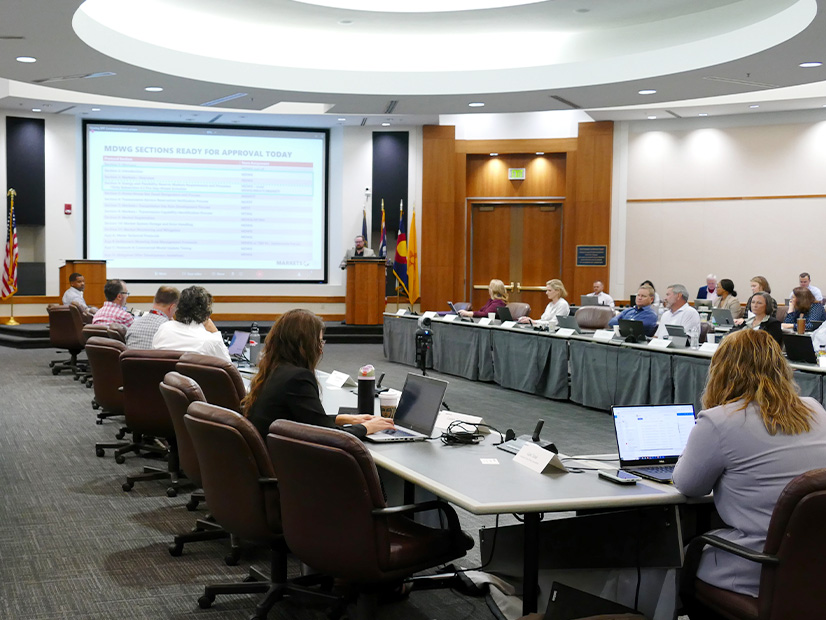WESTMINSTER, Colo. — Meeting with potential Markets+ participants for the first time since FERC filed a deficiency letter over SPP’s tariff filing for the proposed day-ahead market, the grid operator’s staff assured the Markets+ Participant Executive Committee that recent developments have not hindered the RTO’s commitment to Western expansion.
“So far as we’re concerned, nothing’s changed,” Carrie Simpson, SPP’s senior director of seams and Western services, told RTO Insider following the MPEC’s Aug. 13 meeting. “We’re creating what we think is a great product for the West and the best product for the West. We will determine over the next several months who participates, but right now, our focus is the tariff approval.”
FERC issued the deficiency letter July 31, directing SPP to respond to a list of 16 questions related to the tariff. It gave the RTO until Sept. 30 to respond. (See FERC Finds SPP Markets+ Tariff ‘Deficient’ in Several Areas.)
SPP’s legal staff pointed out that the commission’s letter is not a rejection or a likelihood of future rejection, but a “routine process” that SPP has participated in over the years.
“None of the questions indicate to me there’s a serious risk to Markets+,” General Counsel Paul Suskie told the committee. “They indicate to me that FERC is just trying to get additional information.”
Suskie said FERC has sent SPP 41 deficiency letters since 2010. The vast majority (32, or 78.05%) were resolved with SPP’s first response. Of those tariff revisions that SPP refiled, all were approved — including its tariff for the Western Energy Imbalance Services market, in operation since 2021 — except one that is still pending, he said. (See FERC Approves SPP’s Western Market Tariff.)
“I’ve responded to my share of those 41 deficiency letters. This deficiency letter reads to me like FERC wants education. They’ve asked for an explanation,” staff attorney Christopher Nolen said. “Of course, I would prefer the order, but as deficiency letters go, I’m good with this one.”
Nolen said most of the commission’s questions dealt largely with transmission. He noted there were no questions on governance, seams or market fundamentals, saying, “To me, that’s at least as important as the questions they asked.
“I can’t stress enough that they seem to be especially interested in education on how transmission will work in Markets+. If you step back and think about Markets+, how it’s designed and how it works, that’s perfectly reasonable,” Nolen said. “It’s a number of others, a number of parties, a number of balancing authorities, all bringing transmission together for us to effectuate a day-ahead, first-in-class market.”
Staff said they are working quickly to meet the deadline, using examples from stakeholders to respond to the questions. The effort is not expected to delay the 2027 target go-live date or the overall timetable, as SPP has built in additional time to the schedule to serve as a buffer.
“When I ran through these questions on my first pass-through, I thought, ‘Wow, these are all answerable questions.’ So, we have an idea how to answer all these questions,” Nolen said. “I don’t think it will take 60 days.”
SPP said CEO Barbara Sugg’s pending retirement will do nothing to slow its Western expansion, in which the Markets+ service offering will play a large role.
“Our commitment to the West is the strongest it has ever been,” said Antoine Lucas, vice president of markets, stressing that Markets+’s role in the strategy is “unchanged” by Sugg’s decision.
Director Steve Wright said Sugg has done an “outstanding” job and is “extremely committed” to both the RTO and its Western expansion efforts.
“Having said that, there are nine other board members who have been very actively engaged in this process,” he said. “The [board’s] other members have been very interested in this activity as well and have been kept fully briefed as we move along and understand the status of this project, and have been very supportive of it.”
In the meantime, potential Markets+ participants are working on the protocols that will set the market’s mechanics. Three different working groups presented their first batch of protocols for consideration. All were approved unanimously.
The MPEC also approved two chairs to fill vacancies in the stakeholder groups. Puget Sound Energy’s Jessica Zahnow will lead the Markets+ Interim Governance Task Force, and Bonneville Power Administration’s Libby Kirby will chair the Markets+ Operations and Reliability Working Group.
Staff told stakeholders they have board approval to engage with lenders over Markets+’s second-phase funding agreements that will be extended to participants by year-end. SPP expects its administrative costs to run between $65 million and $70 million annually.
Until then, SPP can only wait on FERC’s response to the RTO’s response.
“We anticipate more certainty at that point related to FERC,” Simpson said. “That’ll be the time period when I think parties will decide what they plan to do. We just want them to have choices, at that point.”


